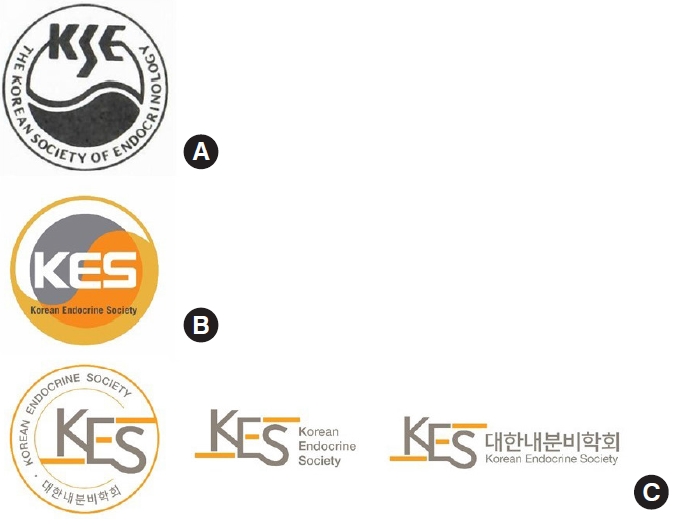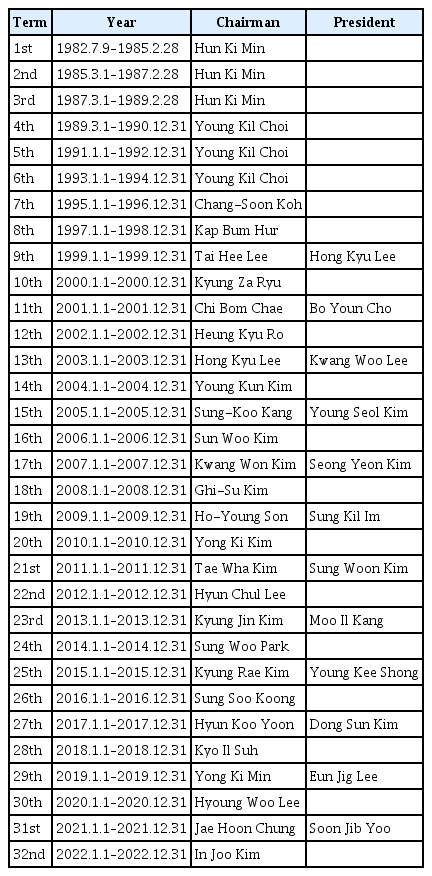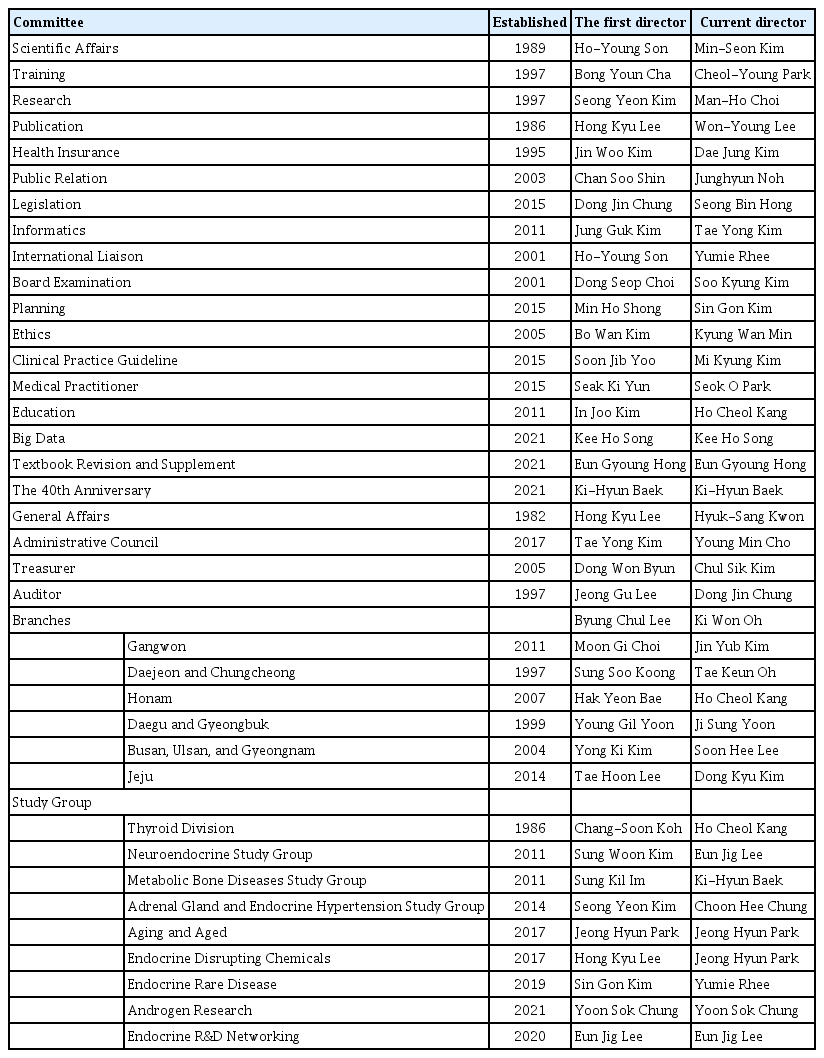Forty Years Together, New Leap Forward! The 40th Anniversary of the Korean Endocrine Society
Article information
On July 8, 2022, the 40th anniversary ceremony of the Korean Endocrine Society (KES) was held at Sofitel Ambassador Seoul Hotel in Jamsil-dong, Songpa-gu, Seoul. The number of members of the KES is 1,738 as of October 2022, and its official journal (Endocrinology and Metabolism [EnM]) has been listed as a Science Citation Index Expanded (SCIE) journal since August 2019. The impact factor of EnM was 3.607 in 2021.
The Seoul International Congress of Endocrinology and Metabolism (SICEM), which is an international academic conference held by the KES, had its 10th anniversary this year. The 10th SICEM took place in Gwangju at Kimdaejung Convention Center between October 27 and 29, 2022. This was the first face-to-face meeting of the KES in 3 years, as the previous two SICEMs were delivered in a virtual format (hybrid) because of the social distancing regulations and public health guidelines associated with the coronavirus disease 2019 (COVID-19) pandemic. The participants were delighted to return to the vibrant, friendly, familial atmosphere of the SICEM as a social meeting and celebrate the 40th anniversary of the KES. The total number of attendees from Korea and abroad returned to the pre-COVID-19 levels. There were many events and displays reminding us that this was the 40th anniversary meeting, including clinical and basic topics based on the outstanding progress that has been made during the last four decades in managing major endocrine diseases (five main symposia discussing about diabetes, bone and mineral diseases, obesity/metabolism, thyroid diseases, and adrenal/pituitary diseases, special symposia, clinical updates, award sessions, hot topics, and meet-the professor sessions). In addition, EnM celebrated its 10th anniversary of publication as an international English academic journal. SICEM provided an opportunity to show the status of the KES, which was founded by our precursors and has grown steadily over the past 40 years (Fig. 1).

History wall of Seoul International Congress of Endocrinology and Metabolism (SICEM) displayed at 10th SICEM in October 27 to 29, 2002.
It is generally accepted that the roots of the establishment of the KES lay in efforts to bring together endocrinology specialists in Korea to attend the Endocrine Symposium, which was held monthly starting on March 28, 1979, with the support of Professor Hun Ki Min of the Medical School of Seoul National University, professor Young Kil Choi of the Medical School of Kyunghee University, and professor Kap Bum Hur of the Medical School of Yonsei University, who were pioneers in endocrinology in Korea. At this first meeting, 13 ‘endocrinologists’ (Gwang Wook Ko, Dong Jip Kim, Seung Jo Kim, Hun Ki Min, Byong Sok Min, Hyung Ro Moon, Sang Ho Baik, Hong Kyu Lee, Sang Yong Lee, Jong Moo Lee, Young Kil Choi, Bum Suk Tchai, and Kap Bum Hur) and colleagues discussed three rare endocrine disorders (intersex, amenorrhea-hyperprolactinemia, and adrenal medullary hyperplasia) in room 4314 of Seoul National University Hospital (new building).
Professor Dong Sun Kim of Hanyang University (the 27th and 28th president of the boards of directors) recalled that as following: This was “the first academic meeting officially held under the name of ‘endocrinology’ in Korea, a peripheral area of modern medicine” (Fig. 2).
After the 17th meeting on June 30, 1982, professor Min and other colleagues finally decided to establish the KES on July 9, 1982 and they launched the inaugural meeting of the KES in Hall A of Seoul National University Hospital (B1F). At this meeting, the regulations required for an integrated society, comprising six chapters and 21 articles, were established. Professor Hun Ki Min was elected as the president, professors Byong Sok Min and Ho Kyung Sung were elected as vice presidents, and 37 members of the society were enrolled. This was the fruition of the incessant passion and dedication of our outstanding precursors in Korea, which was “a peripheral area of modern medicine.” Academic symposia of the KES have been held annually since the first congress in 1985. Thereafter, spring-autumn biannual congresses have been held since 1986. Training workshops have been provided to medical doctors, trainees, and specialists since 1995. Despite being a clinical society, annual symposia on science, education, and technology covering topics in the basic sciences and clinical endocrinology have been held in conjunction with the autumn symposia starting in 1997 in order to stimulate collaboration with basic scientists. In 2013, the KES changed its name of the spring academic conference to the SICEM and started holding SICEM as an international academic conference. Domestic academic conferences are usually held in the fall. Due to the worldwide COVID-19 pandemic, SICEM was postponed in April 2020, held online in October 2020, and held in a hybrid format (both online and on-site) in October 2021 and 2022.
Research on diabetes, a major endocrine disease, played a pioneering role in the development of endocrinology in Korea in 1968 [1]. In addition, clinical practice and research in fields of endocrinology other than diabetes in Korea began in the field of the thyroid, starting with the work of professor Mun Ho Lee at the Department of Internal Medicine of Seoul National University College of Medicine, who studied the medical use of radioactive iodine in Germany, returned to Korea, and started a clinical practice, including thyroid function tests, for the treatment of patients with thyroid diseases in 1957. Later, as medical practice and research on thyroid diseases became more active, the Korean Thyroid Society (KTS) was established on March 24, 1977 due to the need for research and internationalization (president, professor Mun Ho Lee of Seoul National University; secretary, professor Chang-Soon Koh of Seoul National University). Since most members of the KTS who conducted proactive medical practice and research on thyroid diseases were members of the KES, the KTS was merged into a branch of the KES (the Thyroid Division of the KES) in 1986. Due to the explosive increase in thyroid disease and the need for multidisciplinary medical practice, research, and collaboration with international academic societies, the Korean Thyroid Association was established on February 16, 2008 [2].
On November 18, 2005, the name of the society was changed from the Korean Society of Endocrinology (KSE) to the KES at a regular council meeting. After the establishment of the society, the emblem of the KES was created at a council meeting on March 28, 1990, and was amended twice in 2005 and 2018 (Fig. 3). In 2018, the KES announced its new vision (vision 2022: to become a world-class endocrine society) befitting the new era and amended the emblem. The amended emblem maintained the orange color used in the official journal, and the three horizontal lines symbolize stairs going upward to the new vision (by professor Young Min Cho of Seoul National University, former director of the Committee of Planning).

Changes of emblem of the Korean Endocrine Society: (A) 1999 to 2006, (B) 2007 to 2017, and (C) 2018 to present.
It was in July 1978 at Seoul National University Hospital (director, professor Hun Ki Min) that an endocrinology department was first established as a subdivision in a university hospital in Korea, followed by the Catholic University of Korea College of Medicine, Chonnam National University Hospital, and Kyung Hee University Medical Center in the 1980s. On May 31, 1980, the first independent endocrine test laboratory was established at Kyung Hee University Medical Center in Korea. Since then, with the increase in patients with diabetes, thyroid disease, osteoporosis, adrenal gland disease, pituitary gland disease, and other endocrine diseases and the development of the medical system in Korea, the number of medical centers and clinics specializing in endocrinology has increased. Currently in 2022, more than 41 university hospitals and general hospitals have established divisions of endocrinology and metabolism and specialize in treating endocrine diseases. All of them support the current KES. Nurturing professionals in endocrine diseases is one of the main missions of the society. Since its establishment, the KES has been nurturing qualified professionals in the division of endocrinology and metabolism through various training programs. Since 2000, the KES has hosted an annual training course program for fellows in the division of endocrinology and metabolism. This program focuses on in-depth education about medical practice and research for endocrinologist (i.e., subspecialists who have obtained qualifications after being board-certified as internists) and promotes mutual exchange among specialists in internal medicine in Korea. The endocrinology-metabolism subspecialist system started in 1992, and professor Eung Jin Kim was the first physician accredited as a subspecialist through this system. On March 1, 1995, regular training for subspecialists began, and the first subspecialty qualification test was conducted on October 15, 1997. Currently in 2022, the total number of endocrinology-metabolism subspecialists certified by the Korean Association of Internal Medicine is 892. In order to provide up-to-date knowledge about medical practice and research on endocrine diseases to clinicians and professionals in Korea, KES publishes high-quality books including textbooks (Textbook of endocrinology and metabolism, 3rd edition, 2022; Performance and interpretation of endocrine function tests, 2022; Textbook of geriatric medicine and gerontology, 2020; Cushing’s syndrome: diagnosis and treatment, 2019; Fundamentals of clinical research, 2006), Case review in endocrinology and metabolism (2nd edition, 2006), and endocrine glossary (medical terminology of endocrinology and metabolism: https://www.endocrinology.or.kr/glossary/). In addition, the KES provides promotion and guidance activities for rare endocrine diseases to raise awareness to improve the quality of lives of these patients including COVID-19 issues [3-7].
On July 31, 1986, 4 years after the establishment of the KES, the first issue of the Journal of Korean Society of Endocrinology, an official journal of KES, was published. Finally, the KES prepared the groundwork to join the International Society of Endocrinology (ISE), and proactive international academic exchange began in earnest. Professor Hun Ki Min, the president of KES at that time, expressed the society’s journey in an editorial in the first issue as follows:
“Although there are not many people who are interested in endocrinology in Korea, I am proud that their academic level and desire for research are more advanced than those in other fields. Now, since the number of published articles every year is considerable, I believe that the time has come to publish an academic journal. Here, we mark the launch of the first issue. Due to the nature of our society, this journal will publish articles in clinical endocrinology. However, it is also desirable to publish articles in broader areas, such as basic medicine and biology. I also believe that the direction of development of our society is to become a larger society of endocrinology throughout the field of biology, not just in medicine.”
The journal, titled Journal of Korean Society of Endocrinology (until December 2006) and the Journal of Korean Endocrine Society (February 2007 to March 2010), was published twice a year by 1988, three times a year by 1989, four times a year by 1990, and six times a year starting in 2000. The society established an online submission system in 2005 to facilitate the submission process, and the full journal archives were digitized for easy access to our papers and data. Later, the title of the journal was changed to EnM in June 2010, and it has been published fully in English since 2013 (https://www.e-enm.org). Currently, EnM is indexed/tracked/covered by KoreaMed, KoMCI, KoreaMed Synapse, KCI, PubMed (2013), Scopus (2015), Embase, DOAJ (2016), ESCI (2017), MEDLINE (2019), SCIE (August 2019), and ScienceCentral (http://e-sciencecentral.org), which provides free full-text archives of scientific journals published by members of the Korean Federation of Science and Technology Societies with translations into 80 other languages in collaboration with Google Translate [8]. The aim of EnM is to set high standards of medical care by providing a forum for discussion for basic, clinical, and translational researchers and clinicians on new findings in endocrinology and metabolism.
The last decade in life of KES has been marked by establishing SICEM as a stable, high-quality international annual meeting and EnM as a highly qualified journal in the category of Endocrinology, Diabetes and Metabolism (Q2, SJR 0.815, 92nd/240, www.scimagojr.com). The leadership of the KES appreciated early on that an important contribution would be to foster and support endocrinologists in clinical practice, clinical and basic research, and training in the endocrinology subspecialty. The KES currently focuses on organizational development, governance, and sustainable expansion of its mission “Contribution to the progress of medicine through endocrine research.”
Since the first executive team (director, professor Hun Ki Min of Seoul National University) was assembled and founded the society in 1982, about 40 years have passed, and we have reached the 31st and 32nd executive teams (chairman, professor In Joo Kim of Pusan National University, president of board of directors, Soon Jib Yoo of the Catholic University of Korea) starting in 2021 (Tables 1, 2). The number of members when the society was founded in 1982 was only 140, but it reached 1,050 as of December 31, 2009. The steady growth of the KES was noticeable, with the number of members exceeding 1,000 in 26 years. Currently, in October 2022, the 40th anniversary of the society, the number of members has reached 1,738. As about 40 years have passed after the foundation of the society, the KES supports various activities within the society, having established many organizations to promptly respond to needs of health-care system, and research groups on various endocrine diseases that also foster interactions among researchers. Currently, in December 2022, the KES is composed of 17 committees, six branches, and nine research groups, and systematically plays a leading role in medical practice, research, and education on endocrinology in Korea and around the world (Table 3).
Confucius (551 to 479 before Common Era, a Chinese philosopher) said in The Analects that the age of 40 is temptation-proof, meaning “a state of not surrendering to temptation.” [9]. Through its long journey over the past 40 years, the KES has steadily developed to lead globally in clinical practice and research in endocrinology in Korea, which was once a peripheral area of modern medicine. Now is the time to prepare for the 50th and 100th anniversaries of the society. Professor Soon Jip Yoo of the Catholic University of Korea (31st and 32nd president of the board of directors) presented about the 40th anniversary of KES, as follows:
“Celebrating the 40th anniversary of the society, we selected the slogan, ‘40 Years Together, New Leap Forward!’ This slogan is a wonderful expression that vividly shows the identity of our society, which makes its history through collaborative contributions from all members, does not hesitate to take leaps of innovation, and harmonizes tradition and innovation. Now, for a larger leap, we will set a grand vision of ‘KES contributing to the improvement of human health’ and move forward into the future.”
Professor Sin Gon Kim of Korea University (director of the committee of planning) suggested a new vision, KES Innovation 2032—that is, high-quality innovations at various levels for the next 10 years until the KES celebrates its 50th anniversary. In order to develop into a sustainable organization by advancing its core activities, such as clinical practice, research, education, and social contributions, and reducing the social and health-related burdens caused by endocrine diseases, he declared the core values of the society in three key areas (Enterprise, Society, Governance [ESG]). On behalf of the Committee of the KES’s 40th Anniversary, we firmly believe that the KES will continue to progress further and once more express our gratitude to all.
Notes
CONFLICTS OF INTEREST
No potential conflict of interest relevant to this article was reported.
Acknowledgements
We cordially express sincere gratitude to all the board members of the KES and the members of Committee for the 40th Anniversary for their passionate efforts on preparation and on successful completion of the 40th Anniversary ceremony. We also thank the KES secretariate (Sun Joo Lim, Hye Yeon Jang, Ji Soo Hong, and Se Hyun Park) for their infinite support on all of these events.




